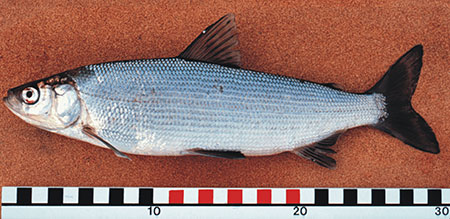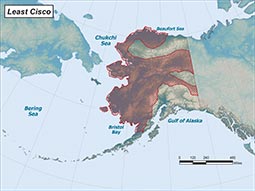Least Cisco
(Coregonus sardinella)
Species Profile
Did You Know?
The least cisco is one of the most abundant freshwater fishes of Alaska.
General Description
The least cisco is a slender salmonid-like fish up to 19 inches in total length. Adult least cisco are distinguished from other adult ciscos of Alaska by the lower jaw, which protrudes slightly beyond the upper jaw when the mouth is closed, and by the pelvic fins, which are dusky to black in color.
Adult least ciscos are generally brownish to dark green dorsally with silvery lower sides and belly. Its dorsal fin is high and separate, while its small adipose fin is placed just anterior to its deeply forked caudal fin. In the ocean, least ciscos have dark spots on their head, back, dorsal, and adipose fins.
Life History
Growth and Reproduction
Least cisco populations in Alaska may be anadromous, which means they spend part of their life in the ocean and part of their lives in fresh water or non-anadromous, spending their entire life in freshwater. Riverine populations of least cisco appear to spawn between late September and early October. Lake resident populations of least cisco, similar in size to riverine populations, also appear to spawn between late September and early October. Dwarf least cisco, which mature younger and at a smaller size, appear to spawn from mid to late September. Least cisco typically reaches sexual maturity between 3 to 8 years of age. Depending on her size, a female least cisco may release from 10,000 to 80,000 eggs. Whitefish eggs are negatively buoyant and non-adhesive. Eggs are broadcast over substrate composed primarily of gravel, sand, or rock in both lotic (riverine) and lentic (lakes or ponds) environments. The eggs presumably hatch in the spring and the young descend downstream to feed and rear in river deltas, estuaries, and nearly coastal environments of rivers which support whitefish populations.
Feeding Ecology
The least cisco have small superior mouths that are ideal for taking swimming prey above or in front of them in the water. Least cisco also feed on a variety of zooplankton including crustaceans, aquatic insects, and small fishes. Adult least cisco does not feed during spawning migrations.
Migration
Anadromous least cisco typically migrates into freshwater systems in late spring to late summer to spawn. Spawning is believed to occur between late September and early October. Least cisco are known to spawn in sections of the Chatanika, Alatna, and Innoko Rivers. Least cisco may spawn in portions or tributaries of the Yukon and Kuskokwim Rivers.
Range and Habitat
In Alaska, least cisco are found from the arctic coast to Bristol Bay and in most streams and lakes north of the Alaska Range. Least cisco are also found throughout Yukon and Kuskokwim River drainages.
Status, Trends, and Threats
Status
Several studies have been conducted on several species of whitefish, including least cisco populations by a number of agencies over the years. Research indicates that Colville, MacKenzie (Canada), Kuskokwim, and Yukon River populations are quite distinct. Such information is very useful when conducting mixed stock analysis on fish collections of unknown origin.
Trends
Overall strength of least cisco returns varies across the state by year and location. Chatanika River least cisco populations have not returned to the abundance observed before the collapse of the fishery during the 1980s. Estimates of harvest rates for the Colville region indicate low to moderate harvest averaging less than 10% from 1985 to 1993. Since then the harvest in the both the commercial and subsistence fisheries has declined. Escapement studies, such as those conducted on Whitefish Lake whitefish populations, have been used to enumerate the numbers of least cisco moving into the lake as adults or out of the lake as juveniles. Currently there is not sufficient data to access the relative abundance of least cisco within or between all known populations throughout the state.
Threats
Potential overharvest from commercial, recreational, or subsistence fisheries is the main threat to the resource. The migratory behavior of the least cisco makes the species particularly susceptible to obstructions such as dams or habitat degradation. Other major ecological changes, such as those associated with the effects of global warming, could adversely affect least cisco populations. Because both climate change and industrial development are occurring simultaneously, it is difficult to attribute changes in fish populations to a single cause.
Fast Facts
-
Size
The least cisco is a slender, medium sized fish known to reach a length of over 19 inches, but is generally smaller. -
Range/Distribution
Found in lakes and streams north of the Alaska Range, from Bristol Bay to the arctic coast, and throughout the Kuskokwim and Yukon River drainages. -
Diet
Zooplankton, including various copepods, cladocerans, mysids, the adults and larvae of a variety of insects, small fish. Least cisco may also eat plant material. -
Predators
Variety of fishes and birds. -
Reproduction
Least cisco may spawn in rivers, streams, lakes, or small ponds. -
Remarks
Managed by the Alaska Department of Fish & Game in Alaska state waters


